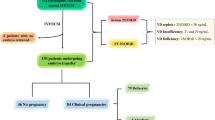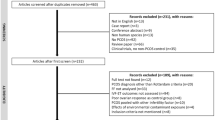Abstract
Retinol (ROL) and its biologically active metabolite, all-trans retinoic acid (ATRA), are essential for a number of reproductive processes. However, there is a paucity of information regarding their roles in ovarian folliculogenesis, oocyte maturation, and early embryogenesis. The objectives of this study were to quantify and compare peripheral plasma (PP) and follicular fluid (FF) retinoid levels, including ATRA in women undergoing in vitro fertilization (IVF) and to investigate the relationship between retinoid levels and embryo quality. Retinoid levels were evaluated in PP and FF from 79 women undergoing IVF at the time of oocyte retrieval and corresponding embryo quality assessed on a daily basis after retrieval for 3 days until uterine transfer. Analysis compared the retinoid levels with day 3 embryo grades and between endometriosis versus control patients. Results demonstrated distinctive levels of retinoid metabolites and isomers in FF versus PP. There was a significantly larger percentage of high-quality grade I embryos derived from the largest versus smallest follicles. An increase in follicle size also correlated with a >50% increase in FF ROL and ATRA concentrations. Independent of follicle size, FF yielding grade I versus nongrade I embryos showed higher mean levels of ATRA but not ROL. In a nested case–control analysis, control participants had 50% higher mean levels of ATRA in their FF and PP than women with endometriosis. These findings strongly support the proposition that ATRA plays a fundamental role in oocyte development and quality, and that reduced ATRA synthesis may contribute to decreased fecundity of participants with endometriosis.
Similar content being viewed by others
References
Jones HW Jr. The use of controlled ovarian hyperstimulation (COH) in clinical in vitro fertilization: the role of Georgeanna Seegar Jones. Fertil Steril. 2008;90(5):e1–e3.
Steptoe PC, Edwards RG. Birth after the reimplantation of a human embryo. Lancet. 1978;2(8085):366.
Patrizio P, Sakkas D. From oocyte to baby: a clinical evaluation of the biological efficiency of in vitro fertilization. Fertil Steril. 2009;91(4):1061–1066.
Ashworth CJ, Toma LM, Hunter MG. Nutritional effects on oocyte and embryo development in mammals: implications for reproductive efficiency and environmental sustainability. Philos Trans R Soc Lond B Biol Sci. 2009;364(1534):3351–3361.
Blomhoff R. Transport and metabolism of vitamin A. Nutr Rev. 1994;52(2 pt 2):S13–S23.
Clagett-Dame M, DeLuca HF. The role of vitamin A in mammalian reproduction and embryonic development. Annu Rev Nutr. 2002;22:347–381.
Niederreither K, Subbarayan V, Dolle P, Chambon P. Embryonic retinoic acid synthesis is essential for early mouse postimplantation development. Nat Genet. 1999;21(4):444–448.
Thompson SY. Factors affecting the absorption of carotene and its conversion into vitamin A. Exp Eye Res. 1964;3:392–404.
Wang X, Penzes P, Napoli JL. Cloning of a cDNA encoding an aldehyde dehydrogenase and its expression in Escherichia coli. Recognition of retinal as substrate. J Biol Chem. 1996;271(27): 16288–16293.
Brown JA, Eberhardt DM, Schrick FN, Roberts MP, Godkin JD. Expression of retinol-binding protein and cellular retinol-binding protein in the bovine ovary. Mol Reprod Dev. 2003;64(3): 261–269.
Graves-Hoagland RL, Hoagland TA, Woody CO. Effect of beta-carotene and vitamin A on progesterone production by bovine luteal cells. J Dairy Sci. 1988;71(4):1058–1062.
Schweigert FJ, Lutterbach A, Rambeck WA, Zucker H. Vitamin A- and beta-carotene concentrations in bovine follicular fluid in relationship to follicle size. Zentralbl Veterinarmed A. 1986; 33(5):360–364.
Schweigert FJ, Zucker H. Concentrations of vitamin A, beta-carotene and vitamin E in individual bovine follicles of different quality. J Reprod Fertil. 1988;82(2):575–579.
Alminana C, Gil MA, Cuello C, et al. In vitro maturation of porcine oocytes with retinoids improves embryonic development. Reprod Fertil Dev. 2008;20(4):483–489.
Gomez E, Caamano JN, Rodriguez A, De Frutos C, Facal N, Diez C. Bovine early embryonic development and vitamin A. Reprod Domest Anim. 2006;(41 suppl 2):63–71.
Haliloglu S, Baspinar N, Serpek B, Erdem H, Bulut Z. Vitamin A and beta-carotene levels in plasma, corpus luteum and follicular fluid of cyclic and pregnant cattle. Reprod Domest Anim. 2002; 37(2):96–99.
Kochhar DM, Jiang H, Penner JD, Johnson AT, Chandraratna RA. The use of a retinoid receptor antagonist in a new model to study vitamin A-dependent developmental events. Int J Dev Biol. 1998; 42(4):601–608.
Lohnes D, Kastner P, Dierich A, Mark M, LeMeur M, Chambon P. Function of retinoic acid receptor gamma in the mouse. Cell. 1993;73(4):643–658.
Lufkin T, Lohnes D, Mark M, et al High postnatal lethality and testis degeneration in retinoic acid receptor alpha mutant mice. Proc Natl Acad Sci U S A. 1993;90(15):7225–7229.
Kane MA, Chen N, Sparks S, Napoli JL. Quantification of endogenous retinoic acid in limited biological samples by LC/MS/MS. Biochem J. 2005;388(pt 1):363–369.
Kane MA, Folias AE, Napoli JL. HPLC/UV quantitation of retinal, retinol, and retinyl esters in serum and tissues. Anal Biochem. 2008;378(1):71–79.
Kane MA, Folias AE, Wang C, Napoli JL. Quantitative profiling of endogenous retinoic acid in vivo and in vitro by tandem mass spectrometry. Anal Chem. 2008;80(5):1702–1708.
Kane MA, Napoli JL. Quantification of endogenous retinoids. Methods Mol Biol. 2010;652:1–54.
Dayal MB, Frankfurter D, Athanasiadis I, Peak D, Dubey A, Gindoff PR. Day 2 embryo transfer (ET) and day 3 ET afford similar reproductive outcomes in the poor responder. Fertil Steril. 2011;95(3):1130–1132.
Desai NN, Goldstein J, Rowland DY, Goldfarb JM. Morphological evaluation of human embryos and derivation of an embryo quality scoring system specific for day 3 embryos: a preliminary study. Hum Reprod. 2000;15(10):2190–2196.
Zeger SL, Liang KY. Longitudinal data analysis for discrete and continuous outcomes. Biometrics. 1986;42(1):121–130.
Scott RT, Hofmann GE, Muasher SJ, Acosta AA, Kreiner DK, Rosenwaks Z. Correlation of follicular diameter with oocyte recovery and maturity at the time of transvaginal follicular aspiration. J In Vitro Fert Embryo Transf. 1989;6(2):73–75.
Revised American Society for Reproductive Medicine classification of endometriosis: 1996. Fertil Steril. 1997;67(5):817–821.
Bo WJ, Smith MS. The effect of retinol and retinoic acid on the morphology of the rat uterus. Anat Rec. 1966;156(1):5–9.
Thompson JN, Howell JM, Pitt GA. Vitamin A and reproduction in rats. Proc R Soc Lond B Biol Sci. 1964;159:510–535.
Deng L, Shipley GL, Loose-Mitchell DS, et al Coordinate regulation of the production and signaling of retinoic acid by estrogen in the human endometrium. J Clin Endocrinol Metab. 2003;88(5): 2157–2163.
Ulven SM, Gundersen TE, Weedon MS, et al Identification of endogenous retinoids, enzymes, binding proteins, and receptors during early postimplantation development in mouse: important role of retinal dehydrogenase type 2 in synthesis of all-transretinoic acid. Dev Biol. 2000;220(2):379–391.
Zheng WL, Sierra-Rivera E, Luan J, Osteen KG, Ong DE. Retinoic acid synthesis and expression of cellular retinol-binding protein and cellular retinoic acid-binding protein type II are concurrent with decidualization of rat uterine stromal cells. Endocrinology. 2000;141(2):802–808.
Bowles J, Knight D, Smith C, et al Retinoid signaling determines germ cell fate in mice. Science. 2006;312(5773):596–600.
Bowles J, Koopman P. Retinoic acid, meiosis and germ cell fate in mammals. Development. 2007;134(19):3401–3411.
Hidalgo C, Diez C, Duque P, et al Oocytes recovered from cows treated with retinol become unviable as blastocysts produced in vitro. Reproduction. 2005;129(4):411–421.
Huang JC. The role of peroxisome proliferator-activated receptors in the development and physiology of gametes and preimplantation embryos. PPAR Res. 2008;2008:732303.
Ikeda S, Kitagawa M, Imai H, Yamada M. The roles of vitamin A for cytoplasmic maturation of bovine oocytes. J Reprod Dev. 2005;51(1):23–35.
Livera G, Rouiller-Fabre V, Valla J, Habert R. Effects of retinoids on the meiosis in the fetal rat ovary in culture. Mol Cell Endocrinol. 2000;165(1–2):225–231.
Zheng WL, Bucco RA, Sierra-Rievera E, Osteen KG, Melner MH, Ong DE. Synthesis of retinoic acid by rat ovarian cells that express cellular retinoic acid-binding protein-II. Biol Reprod. 1999;60(1):110–114.
Schweigert FJ, Steinhagen B, Raila J, Siemann A, Peet D, Buscher U. Concentrations of carotenoids, retinol and alpha-tocopherol in plasma and follicular fluid of women undergoing IVF. Hum Reprod. 2003;18(6):1259–1264.
Hess KA, Chen L, Larsen WJ. The ovarian blood follicle barrier is both charge- and size-selective in mice. Biol Reprod. 1998;58(3): 705–711.
Schweigert FJ, Gericke B, Wolfram W, Kaisers U, Dudenhausen JW. Peptide and protein profiles in serum and follicular fluid of women undergoing IVF. Hum Reprod. 2006;21(11):2960–2968.
Smith FR, Goodman DS. Vitamin A transport in human vitamin A toxicity. N Engl J Med. 1976;294(15):805–808.
Moulas AN, Gerogianni IC, Papadopoulos D, Gourgoulianis KI. Serum retinoic acid, retinol and retinyl palmitate levels in patients with lung cancer. Respirology. 2006;11(2):169–174.
Sedjo RL, Ranger-Moore J, Foote J, et al Circulating endogenous retinoic acid concentrations among participants enrolled in a randomized placebo-controlled clinical trial of retinyl palmitate. Cancer Epidemiol Biomarkers Prev. 2004;13(11 pt 1):1687–1692.
Halme J, Hammond MG, Hulka JF, Raj SG, Talbert LM. Retrograde menstruation in healthy women and in patients with endometriosis. Obstet Gynecol. 1984;64(2):151–154.
Elias JA, Zheng T, Einarsson O, et al Epithelial interleukin-11. Regulation by cytokines, respiratory syncytial virus, and retinoic acid. J Biol Chem. 1994;269(35):22261–22268.
Sago K, Teitelbaum SL, Venstrom K, Reichardt LF, Ross FP. The integrin alphavbeta5 is expressed on avian osteoclast precursors and regulated by retinoic acid. J Bone Miner Res. 1999;14(1): 32–38.
Sharpe-Timms KL. Endometrial anomalies in women with endometriosis. Ann N Y Acad Sci. 2001;943:131–147.
Pavone ME, Dyson M, Reirstad S, et al Endometriosis expresses a molecular pattern consistent with decreased retinoid uptake, metabolism and action. Hum Reprod. 2011; 26(8):2157–2164.
Lebovic DI, Mueller MD, Taylor RN. Immunobiology of endometriosis. Fertil Steril. 2001;75(1):1–10.
Sidell N, Han SW, Parthasarathy S. Regulation and modulation of abnormal immune responses in endometriosis. Ann N Y Acad Sci. 2002;955:159–173.
Author information
Authors and Affiliations
Corresponding author
Rights and permissions
About this article
Cite this article
Pauli, S.A., Session, D.R., Shang, W. et al. Analysis of Follicular Fluid Retinoids in Women Undergoing In Vitro Fertilization: Retinoic Acid Influences Embryo Quality and Is Reduced in Women With Endometriosis. Reprod. Sci. 20, 1116–1124 (2013). https://doi.org/10.1177/1933719113477487
Published:
Issue Date:
DOI: https://doi.org/10.1177/1933719113477487




